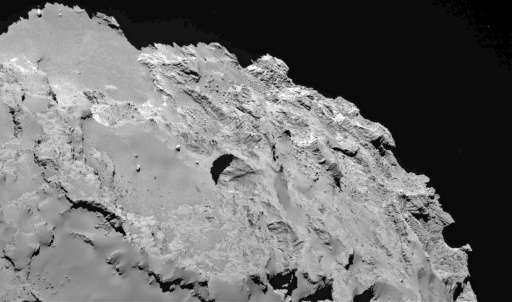Despite rocky start, Philae comet probe has raked in science data

Twelve years ago, the European Space Agency (ESA) launched a spacecraft with a very precious cargo—a robot laboratory designed to land on a comet and photograph, prod and sniff its surface.
The 1.3-billion-euro ($1.5-billion) mission of robot lab Philae and its orbiting mothership, Rosetta, was to shed light on the Solar System's formation, and possibly the origins of life on Earth.
While Rosetta will remain with comet 67P/Churyumov-Gerasimenko until September, scientists on Friday bade farewell to Philae from which there has been no word for seven months.
Philae had 10 instruments, of which eight sprung into action despite a bumpy landing in November 2014.
The lander examined its alien host for 60-plus hours before going into standby mode.
These are some of Philae's contributions to science:
Organic molecules
The lander's COSAC gas analyser sniffed the dust kicked up by Philae's comet ricochet, and identified 16 different carbon-containing organic compounds—found in all living things.
Four of them, methyl isocyanate, acetone, propionaldehyde and acetamide, had never been detected on comets before. Eight comets in total have been visited by spacecraft, but Philae was the first to land on one.
Another instrument, Ptolemy, detected water vapour, carbon monoxide and carbon dioxide in the comet's hazy "coma", as well as organic compounds such as formaldehyde.
"Importantly, some of these compounds detected by Ptolemy and COSAC play a key role in the... synthesis of amino acids, sugars and nucleobases: the ingredients for life," ESA said at the time.
Comets are believed to contain materials left over from the Solar System's formation some 4.6 billion years ago, and scientists see them as time capsules that may provide insights into Earth's own origins.
One theory is that comets smashed into our infant planet, providing it with precious water and the chemical building blocks for life.
Hard on top, porous inside
Many had feared that Philae would land on a soft and fluffy surface, possibly even sink. Instead it bounced when its harpoons failed to fire.
This very rebound, though unintended, allowed scientists to compare the surface characteristics of the spot where Philae first touched down, dubbed Agilkia, and where it finally settled, Abydos.
The lander's ROLIS camera captured a dark, non-reflective surface littered with pebbles and rocks ranging from a few centimetres (inches) across to five metres (5.5 yards).
There was much less water ice than expected.
While the surface at Agilkia was relatively soft, Philae's MUPUS hammer failed to break the surface at Abydos, where it conducted its experiments.
Under a thin dust layer just a few centimetres thick, MUPUS slammed into super-dense mixture of compacted dust and ice.
The hardness of the surface was the "biggest surprise" of 67P, the German Aerospace Centre DLR, which hosts the lander control centre, has said.
In contrast, the CONSERT radar instrument found that inside, the 10-billion-tonne comet was made of a very loosely compacted mix of dust and ice—so porous it would float on water on Earth.
Magnetism
The ROMAP magnetometer found that, surprisingly, the comet had no measurable magnetic field—throwing into question a key theory on the formation of comets and other solar system bodies.
It could mean that magnetic forces may not have played a role, as theorised by some, in a crucial stage of planet building.
© 2016 AFP





















